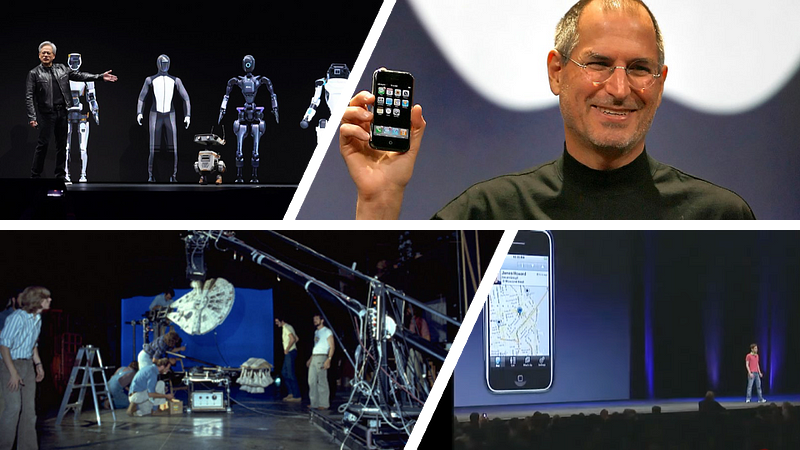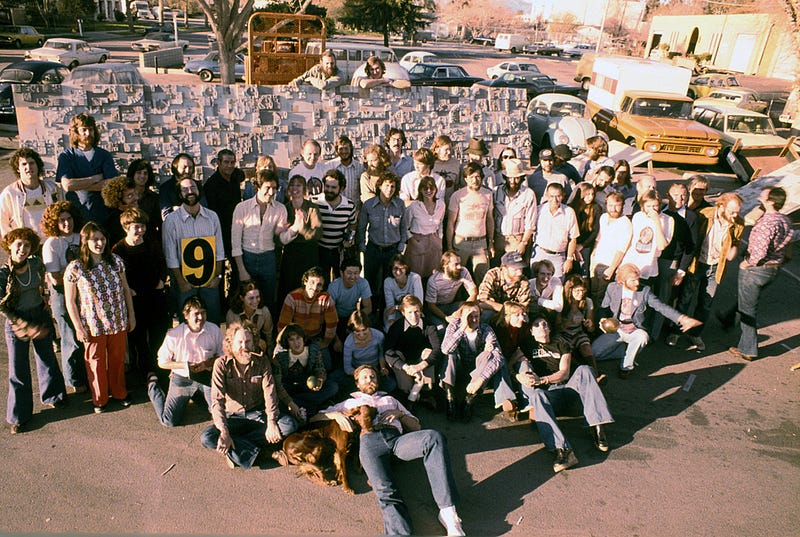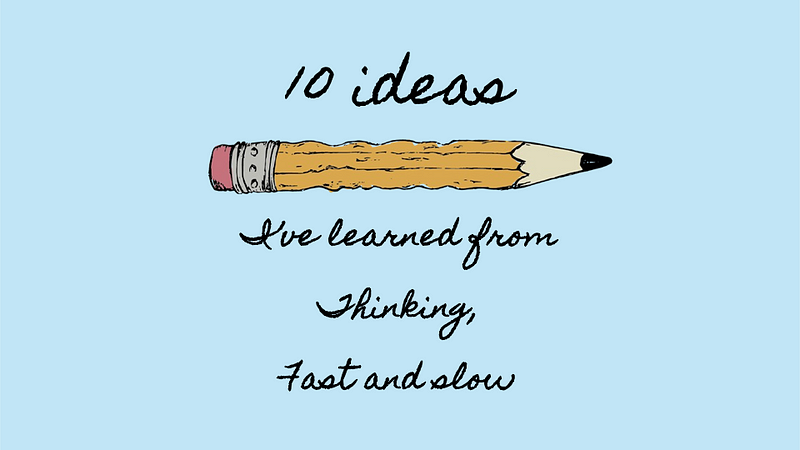The power of story-making in Star Wars, Apple and AI
Storytelling has been around for a long time, but story-making is now grabbing our imaginations for the future.

A long time ago, in a galaxy far, far away…
Or at least that’s how it goes with most of the George Lucas Space Opera franchise, better known as Star Wars.
Star Wars
Unlike its current popularity, which is among the top 5 highest-grossing media franchises at $46.7 billion, its origin story was not as rosy as it sounded.
Plagued with economic inflation and rising oil prices in the 1970s, scepticism against political leaders arose due to the Watergate scandal and the Vietnam War. Even technology was waning as the space race in the 1960s slowed down, and the Internet, smartphones, and computers did not come into existence.
Sounds familiar? We aren’t too far off in the 2020s as the economic cycle goes full circle (or at least 2 rotations) 50 years later. But our perception of life back in the 1970s isn’t so clear, other than some key personal memories from the past.
Traces of a grim, gritty, and downbeat culture could still be seen in popular media, such as the Hollywood films Midnight Cowboys, Bonnie and Clyde, The French Connection, and others.

Partly due to the retiring studios of the early years, the movie industry was also experiencing a decline in innovation. When they passed their reign to large corporations, their marketing teams attempted to slip in business techniques to connect with the younger audience. They, too, were not successful because they didn’t know how to run a movie studio and couldn’t tell a story.
Thankfully, a new hope was created through the rising acclamation from young movie directors like Steven Spielberg emerging from film school. George Lucas was also one of these pioneers, and he pushed the boundaries of the craft by using the latest technology and groundbreaking cinematography. More importantly, he not only knew how to tell a story, but he was determined to make an imaginative story come to life.
We, as human beings, are able to remember stories better than any other species. We can remember stories better than any other information provided to us. As a follow-up to my tribute article about Daniel Kahneman, the legendary researcher had something to say about stories. These are his words:
“No one ever made a decision because of a number. They need a story… Our memory tells us stories; that is, what we get to keep from our experiences is a story.”
And the more incredible the story is, the better the memory sticks. So when you need to film a dogfight in space, how do you go about doing it when the odds are against you?
Industrial Light & Magic
Enlisting the help of John Dykstra to put a crew together, Industrial Light & Magic was born out of a dusty warehouse near an airport to produce many of the most compelling visual effects of Star Wars and Hollywood’s blockbusters.
What made Industrial Light & Magic so successful was the application of the latest techniques developed by their band of makers. They were comprised of concept artists, model makers, photographers, producers, and much more. However, while they had a deep specialty, each of them knew what the other needed because they had prior experience working in the same medium. They were essentially T-shaped people before the term even had a name.

Industrial Light & Magic gathered many first-time achievements, from state-of-the-art motion control camera systems to experimenting with 3D computer-aided modelling. Their resourcefulness and grit over deadlines amazed the industry, attracting more talent to join their team. And despite failures, their lessons helped them produce comebacks and workarounds.
One story was about how model maker Lorne Peterson would ravage parts from a model kit shop to produce miniature X-wings with insane detailing. Another story is how, through observation, concept artist Joe Johnson created the Millennium Falcon by staring at the disposition of dirty dishes at the sink. Or when Phil Tippett conceptualised an orchestra of creatures in a particular alien gangster scene with stop-motions and puppetry.

Seeing is believing, but when something incredible is seen for the first time, it leads the mind to wander and decipher how it could ever be possible. This was what inspired many makers as kids when they saw King Kong or the 2001 Space Odyssey for the first time. They were inspired to make visual effects for themselves. And through their collection of stories, they have inspired others to follow suit. Likewise, they inspire new products to be created, as well as how they ought to be presented.
Apple
It should be no surprise that Steve Jobs would have caught on to the wizardry of storymaking. Having witnessed many feats from his own personal investment, Pixar, which also happened to originate from Lucasfilm, Jobs was able to take that magic and make it real.
Legend has it that Steve Jobs had a dysfunctional iPhone on stage in 2007. Although pressure was mounting to deliver a new smartphone amidst competition, the iPhone was not fully ready for a public debut. Facing internet connection problems, call interruptions, and malfunctions, Jobs went ahead with the live presentation by developing “the golden path"—a carefully scripted set of steps that reduced the margin of errors. This included always-on full signal strength and having multiple iPhones on stage in case one breaks down.
Yet, the live demo was still carried out on a big screen in front of thousands of people, who were seeing a complete touchscreen experience for the first time. The visual effects were catered to the making of the experience, and the story was delivered by the brilliant telling of a master presenter. The rest of it is history.
A year later, someone else took the stage, except he was less known at the time. Spotting a bright pink two-collar shirt, a young Sam Altman took to the stage the same story-making experience of showing how a serendipitous social network app, Loopt, worked. Again, if you are an audience member sitting at WWDC 2008, you are left in amazement at how the technology works and the execution of the idea. With speech alone, people may be suspended in half-belief. Together with the visuals, suddenly, a shimmer of excitement could be felt. Indeed, there is something magical when someone else has something you want in their hands.
AI
The same Sam Altman from 15 years ago is now the CEO of one of the biggest game-changing companies today, OpenAI. At their devday conference in 2023, Sam Altman took to the stage to show how simple it is for anyone to create their own Generative Pre-trained Transformer, also known as GPTs or Agents. With a few clicks and prompts, a GPT can fulfill a specific task you set it out to do. Unlike Steve Job’s demo in 2007, 2023 offered a different context as Sam Alman demonstrated on stage. Today, it is hard to tell whether what we see is fully functioning or if it is still under the category of visual effects. However, the premise is still the same: stories are made to inspire action in people.
Sam Altman is not the only one who harnesses the power of story-making. The president of Nvidia, Jensen Huang, was recently coined the “new Steve Jobs.” And we can see why there is a fair comparison when he is capable of making complex topics sound simple. When there was a need to explain how AI could predict weather patterns, a huge digital-twin globe was used to show the scale and performance of the algorithm. His ability to show his stories through physical representations, demos, and humour makes him both a great story-maker and a visionary leader.
So, when the Project Gr00t Foundation Model for Humanoid Robots was introduced, rather than sticking to digital demonstrations of robots, Jensen Huang invited two actual misbehaving humanoid robots, Orange and Green, on stage based on the technology stacks he shared earlier. Astute observers will notice that these robots are from the Star Wars universe, which brings us back full circle to George Luca’s original vision and limitations in the 1970s. Today, we are one step closer to reality.
The golden path of storytelling has been around for a long time, but it was only in recent times that the power of story-making is starting to grab our imaginations for future technologies. Behind the storytellers are amazing designers and makers who support the vision of their leaders. And wherever the vision goes, the people are not far away. They are, after all, in the same galaxy.
May 4th is a special day for me. As a kid, I was always amazed by the wizardry of the Star Wars movies, so when I learned that there is a special date commemorating Star Wars, I took the writing challenge to write something about Star Wars around this period. Take a look at my last article about the war on stars, and May the Fourth be with you.



